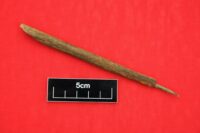 The oldest ink pen ever found in Ireland has been discovered at Caherconnell Cashel, a medieval drystone ring fort in in the Burren, County Clare. The shaft of the dip pen is made from hollow bird bone, the nib from bronze. It dates to the 11th century, a time when literacy was rare and even among the literate elite feather quills were the more common implement.
The oldest ink pen ever found in Ireland has been discovered at Caherconnell Cashel, a medieval drystone ring fort in in the Burren, County Clare. The shaft of the dip pen is made from hollow bird bone, the nib from bronze. It dates to the 11th century, a time when literacy was rare and even among the literate elite feather quills were the more common implement.
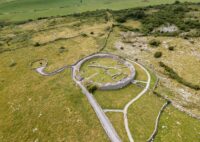 Bigger than most stone ringforts, Caherconnell was in continuous use from when it was built in the late 10th century until the beginning of the 17th, and excavations have recovered thousands of objects and remains. That it was built for a high-status family, local rulers, certainly, perhaps even royal, is attested to by the density, quality and diversity of the artifacts unearthed there. Among the 1800+ objects
Bigger than most stone ringforts, Caherconnell was in continuous use from when it was built in the late 10th century until the beginning of the 17th, and excavations have recovered thousands of objects and remains. That it was built for a high-status family, local rulers, certainly, perhaps even royal, is attested to by the density, quality and diversity of the artifacts unearthed there. Among the 1800+ objects 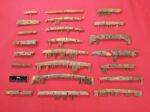 unearthed at the site are fragments from musical instruments, game pieces, coins and items of personal adornment like bone combs, bronze dress pins and amber beads. The large amount of land mammal, bird and fish bones, grains, marine shells and nut shells confirm that the residents of Caherconnell had a plentiful and varied diet.
unearthed at the site are fragments from musical instruments, game pieces, coins and items of personal adornment like bone combs, bronze dress pins and amber beads. The large amount of land mammal, bird and fish bones, grains, marine shells and nut shells confirm that the residents of Caherconnell had a plentiful and varied diet.
The pen was found last year in the 11th century occupation phase of the 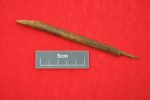 ringfort. The layer also contained other high-status artifacts, including a decorated gold strip. Because ink dip pens are unheard of from this time in Ireland and pens in general were far more the province of the clergy than the laity, elite though they may have been, archaeologists needed to test the object’s function.
ringfort. The layer also contained other high-status artifacts, including a decorated gold strip. Because ink dip pens are unheard of from this time in Ireland and pens in general were far more the province of the clergy than the laity, elite though they may have been, archaeologists needed to test the object’s function.
Those reasons urged caution and lead to the creation of a replica implement to test whether it functioned as a pen. Adam Parsons of Blueaxe Reproductions manufactured the replica, a replica that testing confirmed does work perfectly as a dip pen. So, it seems that this does indeed represent the earliest known ink pen in Ireland.
Feather quills were the more common writing implement at the time, but a pen like the one from Caherconnell would have been ideally suited to fine work – maybe even the drawing of fine lines, as suggested by expert calligrapher and historian Tim O’Neill: “A metal pen from such an early date is still hard to credit! But the fact that it functions with ink is there to see. It would have worked well for ruling straight lines to form, for instance, a frame for a page.”
While Church scribes copied and created all manner of ecclesiastical texts, it seems likely that a secular scribe might have used a pen like this to record family lineages and/or trade exchanges.
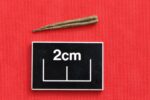 There is evidence of international trade (foreign coins, imported objects) at the fort, and given the huge quantities of animal bones and waste from metalworking and textile production, Caherconnell’s owners had plenty of things to keep track of and inventory.
There is evidence of international trade (foreign coins, imported objects) at the fort, and given the huge quantities of animal bones and waste from metalworking and textile production, Caherconnell’s owners had plenty of things to keep track of and inventory.